Life Cycle of Cycas
<<< Part 7
This is the Final Part (Part 8) of the Lecture Notes Series in Cycas. Here we will continue the discussion on Sexual Reproduction in Cycas. In the previous post, we discussed the development of Male and Female Gametophytes of Cycas. Here we will see the process of fertilization and Embryo Development in Cycas. We will also look into the structure of the mature embryo of Cycas, the features of seeds and the seed germination process. The Life Cycle and Economic importance of Cycas are also summarized.
Fertilization
♣. When archegonia are mature, the roof of the archegonial chamber (made of nucellar tissue) disintegrates and the cell contents are quickly absorbed by the surrounding cells.
♣. With the dissolution of the roof of the archegonial chamber, now the pollen chamber and archegonial chamber form a common cavity.
♣. The pollen tube ruptures and its content along with sperm cells are discharged into the archegonial chamber.
♣. Spermatozoids can swim in the fluid to reach the neck of the archegonium.
♣. The neck opens and the entire sperm cell (not the nuclei alone) as such enter into the archegonium.
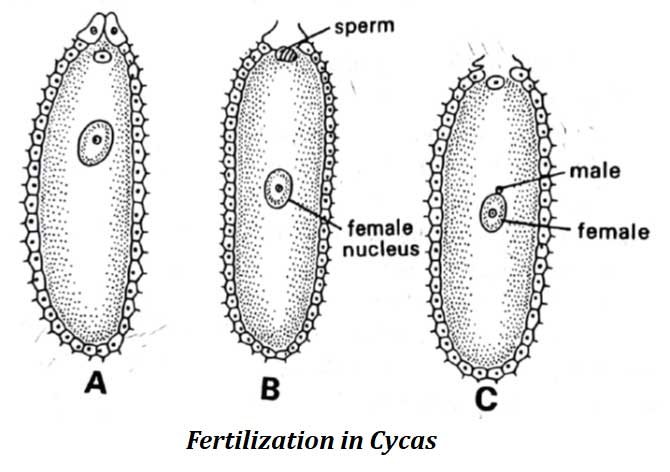
♣. Immediately after the entry, the cytoplasm and the cilia of the sperm are removed.
You may also like: Cycas PPT (Download)
♣. The naked sperm nucleus moves to the egg nucleus and fuses with it.
♣. The fertilization is achieved and the diploid Zygote (‘oospore’) is formed (2n).
♣. The zygote or ‘Oospore’ is the first cell of the sporophytic generation.
♣. The fertilization in Cycas is siphonogamous as in Angiosperms.
♣. Siphonogamous: A condition where the fertilization is achieved through a pollen tube as in Gymnosperms and Angiosperms. (Siphon meaning tube).
Development of Embryo in Cycas
♣. There is NO resting period for the zygote, the embryo development starts immediately after fertilization.
♣. First, the zygote undergoes free-nuclear division (nuclei divide continuously without cell wall formation).
♣. Then, a vacuole is formed in the center of the cell.
♣. The vacuoles push the nuclei towards the periphery.
♣. The multinucleate structure thus formed is called the Pro-embryo.
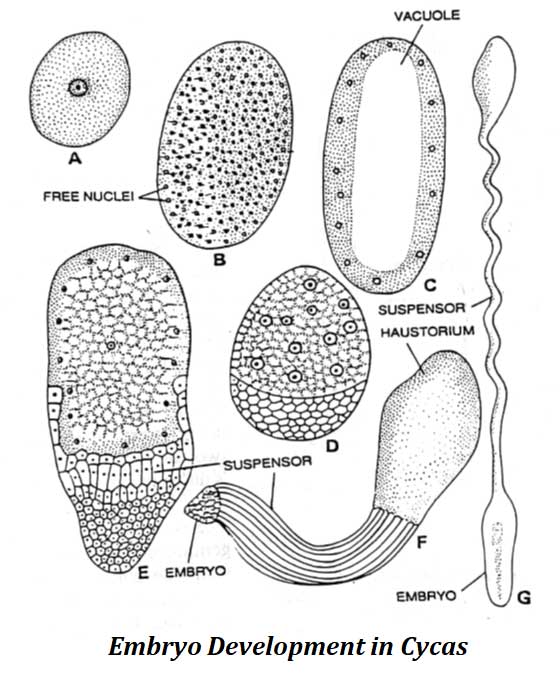
♣. Then, the cell wall formation occurs at the lower portion of the pro-embryo.
♣. The pro-embryo thus is differentiated into THREE regions
♣. Cells encircling the central vacuole form the haustoria.
♣. Cells immediately beneath the haustoria form the suspensor.
♣. Cells at the tip region become meristematic and form the embryo proper.
♣. The suspensor region of the pro-embryo elongates.
♣. As the suspensor elongates, the embryo proper is pushed deep into the embryo-sac (now it is the endosperm)
♣. In Cycas, the suspensor is long and unbranched.
♣. Suspensors developed from all fertilized archegonia become twisted each other.
♣. Usually, only one embryo develops and all others get aborted.
♣. As the embryo matures, the suspensor pushers the embryo deep into the embryo-sac (endosperm).
♣. The coleorhiza develops at the base of the embryo.
♣. At the opposite end, two cotyledons and a stem tip are differentiated.
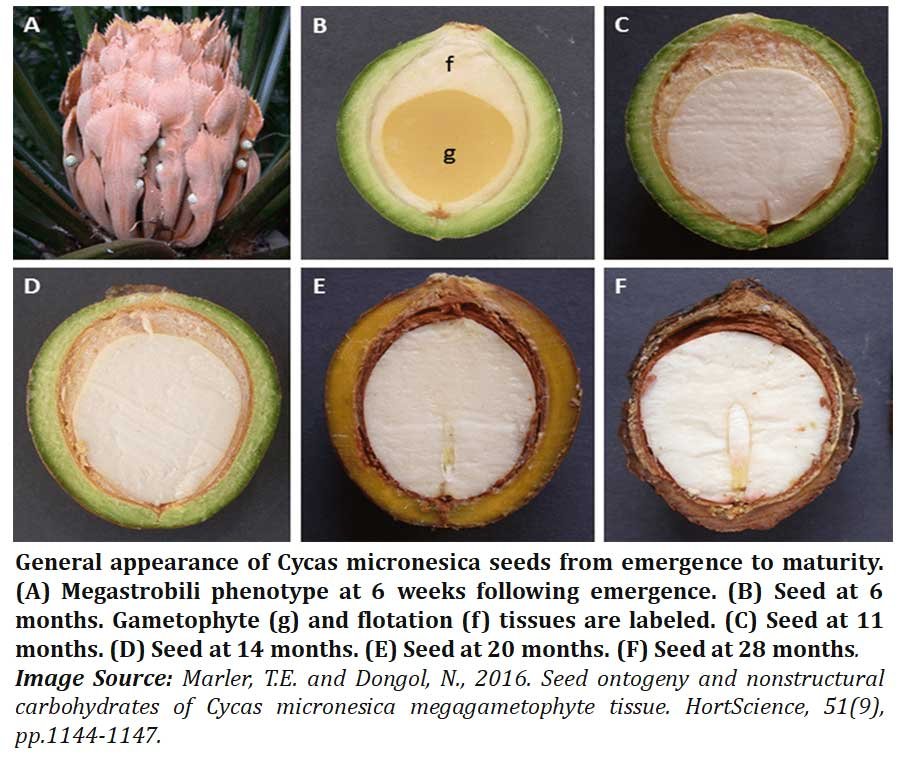
Seed of Cycas
♣. The mature seed of Cycas is composed of a fleshy outer coat developed from the outer portion of the integument, a stony inner coat developed from the stony layer of the integument and in the centre, a single embryo.
♣. The embryo of Cycas is straight with two unequal cotyledons.
| You may also like NOTES in... | ||
|---|---|---|
| BOTANY | BIOCHEMISTRY | MOL. BIOLOGY |
| ZOOLOGY | MICROBIOLOGY | BIOSTATISTICS |
| ECOLOGY | IMMUNOLOGY | BIOTECHNOLOGY |
| GENETICS | EMBRYOLOGY | PHYSIOLOGY |
| EVOLUTION | BIOPHYSICS | BIOINFORMATICS |
♣. The plumule is situated between the cotyledons.
♣. The axis of the embryo consists of hypocotyl and radicle.
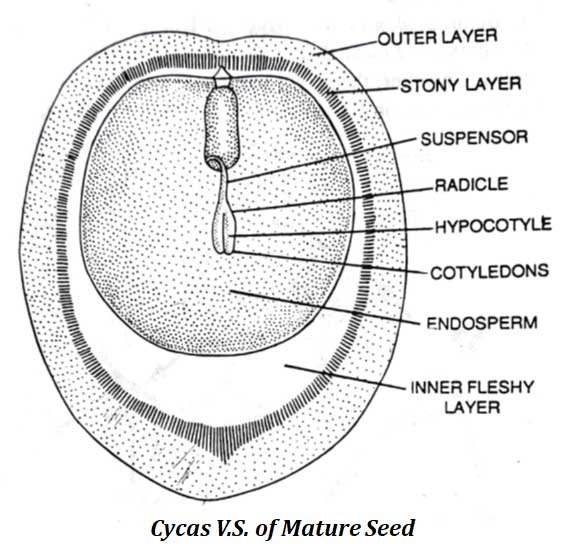
Seed Germination
♣. The Cycas don’t have any resting period. The seeds germinate immediately when they fall from the mother plant.
♣. During germination, the coleorhiza comes out first.
♣. The major portion of the cotyledons then comes out.
♣. Some portion of the cotyledons remains inside until the whole endosperm is transferred to the cotyledons.
♣. Leaf gradually develops, for several years only one leaf is produced.
♣. Later many leaves are produced. The growth rate is very slow.
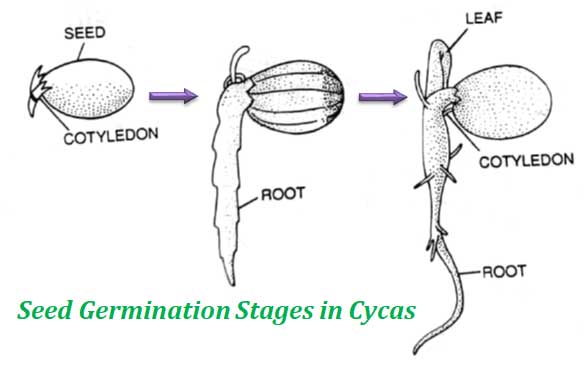
Life Cycle of Cycas
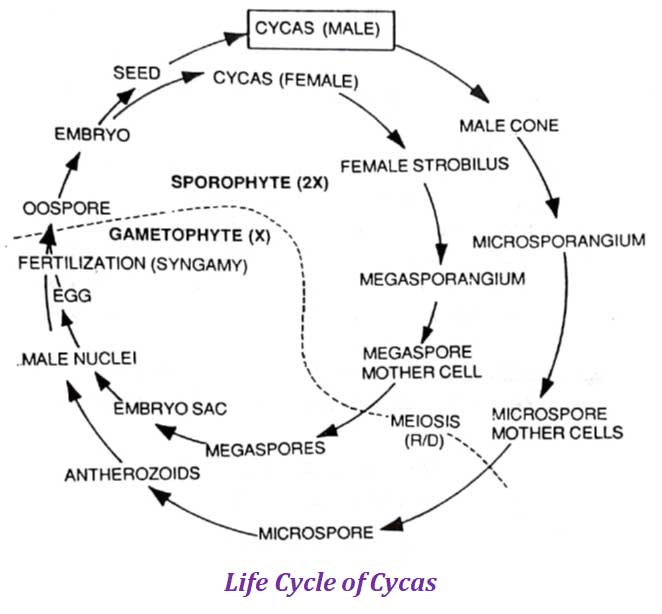
Economic Importance of Cycas
Learn more: Economic Importance of Gymnosperms
♣. Cycas revoluta yields sago (Sago Palm).
♣. Sago is a starchy secretion obtained from the stem of Cycas.
♣. Cycas revoluta is an ornamental plant.
♣. Seeds of some Cycas species are edible and they are eaten boiled or roasted.
♣. Leaves of Cycas are used as decorative bouquets and wreaths.
♣. Leaves of C. circinalis are used for making mats.
♣. Young leaves of Cycas are used as vegetables.
♣. In some species, the uncooked seeds are poisonous.
<<<Back to Botany Lecture Notes Home Page
| You may also like... | ||
|---|---|---|
| NOTES | QUESTION BANK | COMPETITIVE EXAMS. |
| PPTs | UNIVERSITY EXAMS | DIFFERENCE BETWEEN.. |
| MCQs | PLUS ONE BIOLOGY | NEWS & JOBS |
| MOCK TESTS | PLUS TWO BIOLOGY | PRACTICAL |

Nice and simple explanation 🔥